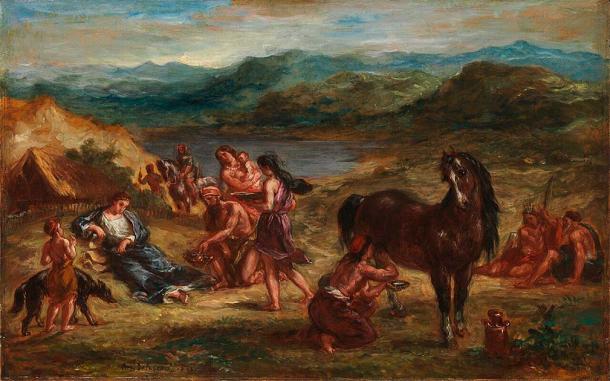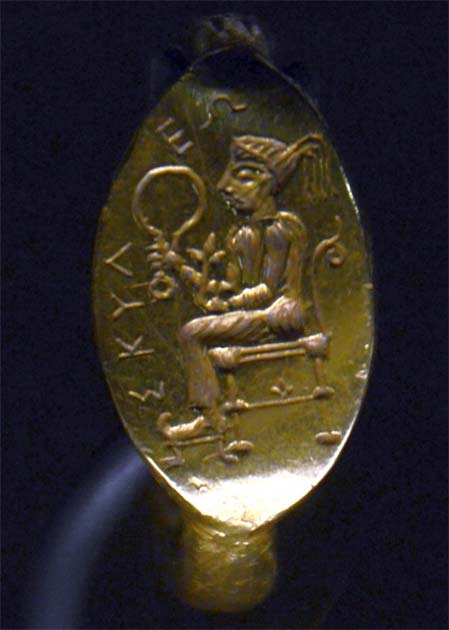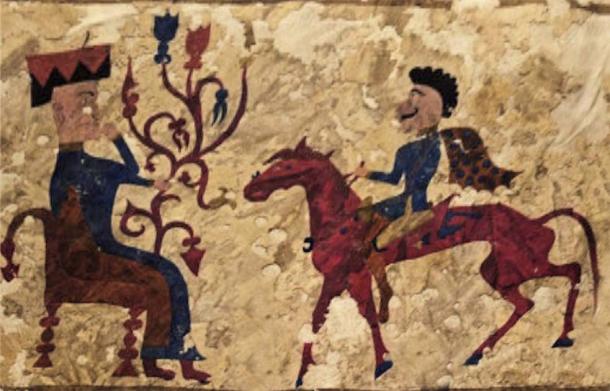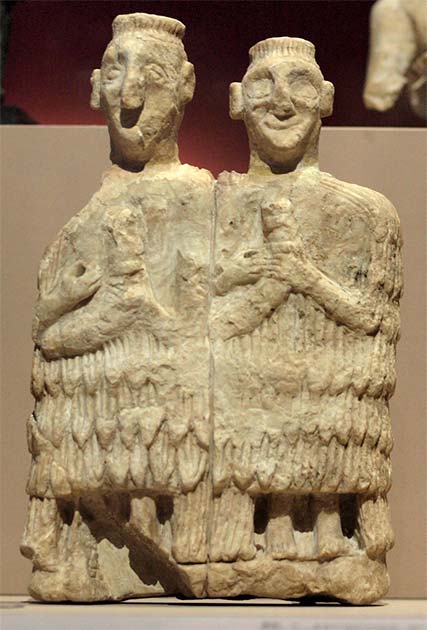The Mysteries of the Enaree: The Androgynous Shamans of the Scythians
Throughout history, shamans played a major role in many of the world’s most important civilizations. For the ancient Scythians, this role was taken by the Enaree, male priests and shamans who adopted a specifically androgynous and effeminate aspect, worshiping the goddess Artimpasa.
The Enaree were one of the major aspects of Scythian religious practice, sharing aspects with many similar effeminate priests of neighboring cultures. Ancient Greek historians, such as Herodotus of Halicarnassus and Pseudo-Hippocrates, left valuable writings focused on these enigmatic androgynous shamans. What were they like? And what role did they play for the warlike Scythians?

Ovid among the Scythians (1862 ) by Eugene Delacroix. (Public domain)
The Enaree and the Complex Scythian Beliefs
These shamans are known in English as Enaree, which itself is derived from the ancient Greek name that Herodotus of Halicarnassus recorded in his writings: Enarees (Εναρεες). This was a Greek transliteration of the native Scythian term Anarya, meaning simply “unmanly”. The name was composed of elements a-, meaning “non”, and narya, derived from nar and meaning “man”.
The native name is also a clear indication of the appearance and lifestyle that these shamans adopted. Compared to the warlike and masculine culture of the Scythians, the effeminate Enaree were certainly seen as unmanly, even though they played a key role in religious practices.
The Enaree were a part of an orgiastic cult of the major Scythian goddess, Artimpasa, as well as of the ancestral mother-goddess of the Scythians, the Snake-Legged Goddess. Both were strongly influenced by Near Eastern fertility deities, with which the Scythians came into touch early in their history.
- Scythian Priesthood of Fierce Fighting Eunuch Shamans of the Snake Goddess
- A Warrior’s Face Frozen in Time, Gold, Hemp, Tents and Cheese Tell the Scythian Tale
The most notable foreign adoption was a shamanistic role, non-native to the Scythians. They adopted this from the native Siberian tribes, where shamans were a major part of society. Mixing that with their own religious beliefs, the Scythians developed a unique practice which was manifested in the Enaree priests.
The Scythians were nomadic horsemen, having contacts with many of their diverse neighbors in all directions. The result of this was their ability to be influenced by many completely opposing cultures and adopt their practices into their own. This meant that their culture was incredibly diverse and rich as a result.

The Enaree were a part of an orgiastic cult of the major Scythian goddess, Artimpasa. In the image, the seated goddess Artimpasa, depicted on the ring of King Scyles. (Public domain)
Orgies, Shamans and Androgyny Amongst the Enaree
In the ancient world, a lot of things that are considered taboo today, were completely normal. And if seen from today’s perspective, almost everything that the Enaree did can be seen as taboo. These shamans were amongst the earliest spiritual practitioners to have used cannabis in order to alter their state of consciousness, either for communal practices, or funerary and psychopompic ones. According to scholars, this implies “that an ancient connection existed between gender non-conforming spiritual practitioners and the use of mind-altering substances.”
Lavish burials were important for the Scythians, whose tumuli still stand today after many centuries. And in those burials, the Enaree played a crucial role, conducting their shamanistic practices to help the deceased depart to the afterworld.
After the burial, the Enaree would ritually clean themselves with the vapors of the cannabis plant, which has been attested archaeologically in Saka Scythian tumuli. In these were discovered various receptacles containing remnants of cannabis, including tripods, braziers and incense burners. One of the famous Pazyryk Scythian burials contained a pot inside which were fruits and cannabis, and a copper censer in which the latter was burned.
The Enaree played numerous roles in Scythian society, one of which was the role of divination. They acted as seers, and performed special forms of divination that utilized the inner bark of the linden tree. They would cut the inner bark of the linden into three pieces, and then plaiting and unplaiting them around their fingers in order to obtain the answers they wanted. For example, whenever a Scythian King would fall ill, the Enaree were called in to divine and discover which enemy had “bewitched” the King.
“The Anarya were especially consulted when the king of the Scythians was ill, which was itself believed by the Scythians to be caused by a false oath being sworn upon the king's hearth. Once the Anarya had identified the suspect who had sworn the false oath, the said suspect would claim to be innocent. If the Anarya maintained the accusation, six more soothsayers were consulted, and if they upheld the original accusation, the suspect was executed by being beheaded. If the additional soothsayers declared the suspect was innocent, the process of consulting more soothsayers was repeated. If the soothsayers all found the accused to be guilty, the culprit was executed through beheading, and his property was divided among the Anarya who had found him guilty. If the larger number of soothsayers still declared the suspect to be innocent, the initial accusers were executed by being put into an oxen-pulled wagon filled with brushwood which was set on fire was made to be pulled by the oxen, who eventually also burned along with the wagon and the disgraced soothsayers; the sons of these Anarya were also all killed, but their daughters were spared.”

Decorated tapestry depicting the seated goddess Artimpasa and a Scythian rider from circa 241 BC. (Public domain)
The Enaree as Diviners and Deciders of Scythian Fate
Being influenced so strongly by Siberian shamanistic practices, the Enaree likely wore the same style of ritual clothes and used the same implements. For example, they wore deer-antlered headdresses, and used ritual drums. This has been confirmed by finds in Scythian burials.
Also, the Enaree were easily distinguished by the special scepters they carried, which were their personal symbols of authority. The scepters were long poles topped with special ornate sculptures, which varied from region to region. Such scepters were discovered from as far east as Mongolia, and far west to the Great Hungarian Plains. The oldest discovered date to the 8th century BC, and were found in the burials at Minusinsk Basin in modern Russia.
Most commonly, the scepters of the Enaree were topped with carved ibex or stags, standing as if perched on “a rocky eminence.” As centuries passed, the scepters too became more ornate and lavish, sporting all sorts of tops.
Some, like the ones found in Oleksandropilskiy Kurhan tomb, have an intricately carved goddess with her hands on her hips, and another has a griffin with space for two hanging bells. Bells and rattles were always present on these scepters, announcing the Enaree’s approach with their sounds. Also, when a shaman rattled his scepter, the noise invited the audience to observe the rites.
The Enaree were members of the most influential aristocracy among the Scythians. They were originally born as males but adopted the attire and roles traditionally associated with women. They spoke and behaved like women, and the Scythians believed they possessed a unique and divine androgynous nature.
According to indigenous Scythian shamanic customs, the Enaree were regarded as “transformed” shamans who underwent a change in their gender, marking them as the most powerful shamans. This distinction instilled fear and earned them special respect within Scythian society. The Scythians attributed their androgyny to a “female ailment” that resulted in sexual impotency.

Scythian tiara depicting the goddess Artimpasa surrounded by priestesses, including an Enaree on the right. (Public domain)
Androgynous Priests in History
The androgyny of the Enaree went even deeper than the physical appearance. Even the goddesses they worshiped were seen as androgynous: Artimpasa had the power to turn men into women, while the Snake-Legged Goddess was often presented with a beard.
These were the crucial aspects of the so-called “gender-crossing shamanism,” where men acquired the power of prophecy by abandoning their masculinity. In this way, they could become powerful religious figures who were in touch with the spirits. Such practices survived to the modern times amongst the indigenous Siberians.
However, it is not known whether the Enaree practices ritual castration in order to fully denounce their masculinity, or they simply refrained from heterosexual intercourse. Pseudo-Hippocrates writes that they were not celibate, and suggests that they could have engaged in sexual intercourse with men, where they played a receptive role.
Furthermore, it is suggested that they only adopted their “transvestite transformation” later in their lives, when they would discover that they were no longer able to have sexual intercourse. Up to that point, they would live their lives as men.
Interestingly, the Enaree were not the sole examples of androgynous priests in history. There were many examples in different cultures and religions, such as the Kelabim of ʿAštart, the Galli of Kubeleya, and the Phrygian Megabyzoi or Megabyxoi of Ephesian Artemis.
They appear even earlier in history, far back in time with the first civilization of the world, the Sumerians. The Sumerians had their own Gala priests of the Goddess Inanna. These priests were effeminate men who adopted female priestly roles, especially in relation to soothing singing in religious practices. And just like the Enaree, they often fully renounced their masculinity.

Enaree were not the only example of androgynous priests in history. The Sumarians had their own Gala priests of the Goddess Inanna, seen in this ancient Sumerian statuette dating to c. 2450 BC. (Applejuice / CC BY-SA 4.0)
Transfeminine Enaree within Scythian Society
The Scythian society was organized into different tribes and clans, and the Enaree existed as a distinct group within this larger society. They were not a separate ethnic group but rather a unique social and religious caste within the broader Scythian culture.
Alas, the role and influence of the Enaree in Scythian society gradually declined over time, as Scythian culture evolved and as the region came into contact with other cultures through trade and conflict. By the time of Herodotus' writings in the 5th century BC, their influence had begun to wane. In the 7th century BC, the Scythians expanded into West Asia. During this period, the Scythian religious beliefs were influenced by the faiths of the people in the Fertile Crescent.
- Grave of Female Scythian Warrior Found in Ukraine
- Surprising 5,000-Year-Old Cannabis Trade: Eurasian Steppe Nomads Were Earliest Pot Dealers
According to Scythian mythology, the androgynous nature of the Anarya people was believed to have originated due to a curse cast by the goddess Artimpasa upon those responsible for sacking the temple in Ascalon, dedicated to the goddess Astarte. Astarte herself was seen as an androgynous deity associated with vegetation and fertility, possessing the power to transform men into women and women into men.
The Scythians identified Astarte with their own goddess Artimpasa, and this hereditary curse was passed down through the descendants of the temple's attackers. The concept of transvestite androgyny among the Anarya was thus a characteristic shared with the Levantine celestial ʿAštart cult.
The Enaree are a fascinating example of how ancient cultures sometimes had fluid and non-binary concepts of gender roles and how certain individuals or groups could hold unique religious and societal roles that defied traditional norms. In so doing, they offer us a unique glimpse into the complexities of ancient Scythian society. Their androgynous religious practices and gender ambiguity challenge conventional notions of gender roles, highlighting the diversity and fluidity that existed in the past.
The Enaree's role in Scythian culture as diviners and advisers to leaders underscores their significance in the spiritual and political spheres of their time. As we explore the annals of history, the Enaree stand as a testament to the rich tapestry of human culture, where diversity, spirituality and the quest for understanding have always been part of the human experience.
Top image: Representative image of a Scythian Enaree shaman. Source: jozefklopacka / Adobe Stock
References
Bolich, G. 2007. Transgender History & Geography: Crossdressing in Context. Lulu.
Cunliffe, B. 2019. The Scythians: Nomad Warriors of the Steppe. Oxford University Press.
Ivantchik, A. 2018. “Scythians” in Encyclopædia Iranica. Brill Publishers.

















